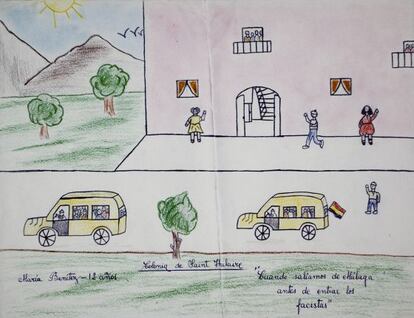A child’s-eye view of the Civil War
Psychologist’s new book analyzes 142 pictures by young Republican evacuees


In February 1937, 12-year-old María left Málaga in a bus bound for Almería. Faced with the unstoppable advance of the fascist troops, the girl was then transferred to a camp in the south of France. There, at the request of a Quaker-run humanitarian organization, she expressed the memories of her evacuation in a picture.
In her childish style, the little girl drew two buses, one of which was carrying a Republican flag at the back. She included some low-level houses, like those occupied by the bourgeoisie in the east part of Málaga. At the bottom she wrote: “When we left Málaga, before the fascists entered.”
The drawing is number 26 of the 142 studied by José Antonio Gallardo, a psychology professor at the University of Málaga (UMA), for his book El dibujo infantil de la evacuación durante la Guerra Civil (or, Childhood drawings of the evacuation in the Civil War), and the one that made the biggest impression on him.
“Looking at them you cannot tell if the child who has experienced and drawn a bombing is more traumatized than the one who gave expression to an evacuation and drew a sun and some flowers,” he says.
Gallardo has devoted nearly 10 years to collecting and analyzing the pictures, gathering more than 2,200 examples. The majority of those come from the Quaker organization that traveled to Spain in 1937 to collect the drawings of evacuated Republican children at different camps, both inside and outside the country.
These served as the basis for an exhibition on the ground floor of the Lord & Taylor department store on Fifth Avenue in New York. The auction of some of those works and the show catalogue, which included an introduction by Brave New World author Aldous Huxley, helped raise funds for the Republican government.
Gallardo located the drawings at the universities of California, San Diego and Columbia, in New York; in a book shop in Ontario, Canada; and in the National Library of Spain, among other places.
In the end, he opted to focus on the works in which the children, aged between six and 15, portrayed their evacuations. “It is the event that most clearly shows the psychological impact of the war, and about which there is the biggest bibliography,” says the professor.
One frequent characteristic of the pictures is the absence of limbs on some of the figures drawn by the children. “In one of them there are people running and none of them has any arms. Karen Machover, a North American psychologist with expertise in children’s drawing, had already found back in the 1950s that this was a sign of post-traumatic stress,” he says.
The pictures reflect the sadness of the children as much as the fear and uncertainty of the adults. Ricardo, 12, painted his mother ironing. “The figure is scary. The face reflects the mother’s anxiety and fear at finding out her child is going away from home without knowing for how long.”
Drawing number two, by Antonio, shows his father with a bandage on his head, “and a complete collapse of morale.”
El dibujo infantil de la evacuación durante la Guerra Civil is published by the University of Málaga and all profits will go to the Red Cross.
Tu suscripción se está usando en otro dispositivo
¿Quieres añadir otro usuario a tu suscripción?
Si continúas leyendo en este dispositivo, no se podrá leer en el otro.
FlechaTu suscripción se está usando en otro dispositivo y solo puedes acceder a EL PAÍS desde un dispositivo a la vez.
Si quieres compartir tu cuenta, cambia tu suscripción a la modalidad Premium, así podrás añadir otro usuario. Cada uno accederá con su propia cuenta de email, lo que os permitirá personalizar vuestra experiencia en EL PAÍS.
¿Tienes una suscripción de empresa? Accede aquí para contratar más cuentas.
En el caso de no saber quién está usando tu cuenta, te recomendamos cambiar tu contraseña aquí.
Si decides continuar compartiendo tu cuenta, este mensaje se mostrará en tu dispositivo y en el de la otra persona que está usando tu cuenta de forma indefinida, afectando a tu experiencia de lectura. Puedes consultar aquí los términos y condiciones de la suscripción digital.
Últimas noticias
The complicated life of Francesca Albanese: A rising figure in Italy but barred from every bank by Trump’s sanctions
Pinochet’s victims grapple with José Antonio Kast’s rise in Chile
Reinhard Genzel, Nobel laureate in physics: ‘One-minute videos will never give you the truth’
How Japan is trying to avert ‘digital defeat’
Most viewed
- Why we lost the habit of sleeping in two segments and how that changed our sense of time
- Pablo Escobar’s hippos: A serious environmental problem, 40 years on
- Trump’s obsession with putting his name on everything is unprecedented in the United States
- The Florida Keys tourist paradise is besieged by immigration agents: ‘We’ve never seen anything like this’
- Charles Dubouloz, mountaineering star, retires at 36 with a farewell tour inspired by Walter Bonatti








































